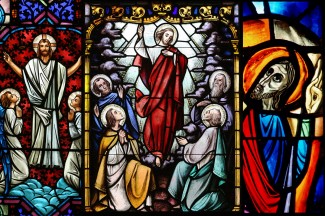
The Ascension refers to the day celebrated 40 days after Easter when Catholics celebrate the fact that Jesus returns to God after being with his disciples after the resurrection. It is a central element of our tradition and is included in the creed recited at Mass each Sunday. If a diocese celebrates the Solemnity of the Ascension on a Thursday, it is a Holy Day of Obligation and Catholics are required to go to Mass on that day. The celebration of the Solemnity of the Ascension may also be transferred to the Seventh Sunday of Easter.
The scriptural basis for this feast comes from Acts 1:9-11.
And after He had said these things, He was lifted up while they were looking on, and a cloud received Him out of their sight.
And as they were gazing intently into the sky while He was going, behold, two men in white clothing stood beside them. They also said, “Men of Galilee, why do you stand looking into the sky? This Jesus, who has been taken up from you into heaven, will come in just the same way as you have watched Him go into heaven.”
RELATED: A Grand Entrance: What the Ascension is Really About
This is not meant to be taken as a literal passage in the sense of a “beam me up” kind of story. The Ascension signifies that Christ is no longer bound by the time and space that he was while he was in the fullness of his humanity. Jesus is Lord and that means that Lordship goes beyond mere humanity. Others may claim kingship but the only one who is Lord and King is Jesus. Most importantly, the day signifies that God can be experienced anywhere and not just in time and space.




